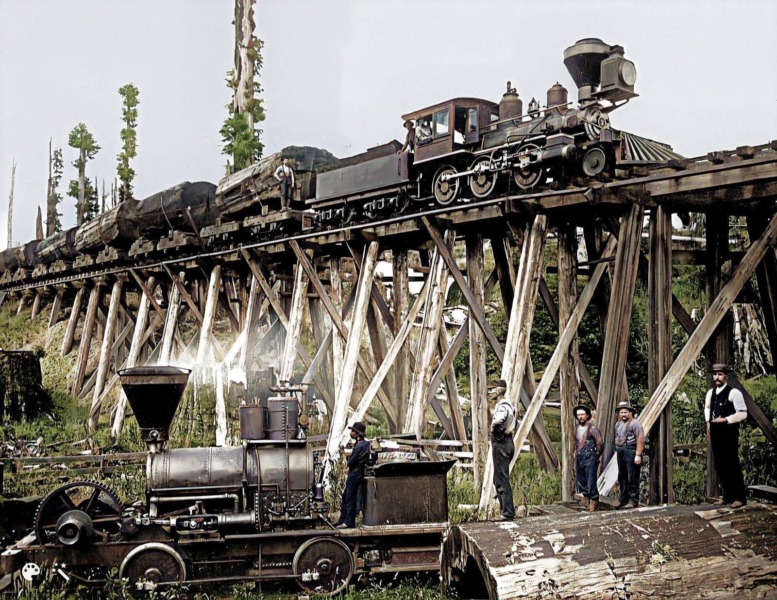Navigation
Install the app
How to install the app on iOS
Follow along with the video below to see how to install our site as a web app on your home screen.
Note: This feature may not be available in some browsers.
More options
You are using an out of date browser. It may not display this or other websites correctly.
You should upgrade or use an alternative browser.
You should upgrade or use an alternative browser.
Anyone Else Fascinated By Old Locomotives?
- Thread starter Black 03 Z06
- Start date
TIMBER TRAIN CHUGS ACROSS A TRESTLE NEAR TRINIDAD AT THE BEGINNING OF THE LAST CENTURY
Monday, 12 September 2022, 1:03 pm Kym Kemp 19 commentsOne log per car. Huge !

Eureka & Klamath River RR. Train, crossing a trestle near Crannell, CA. [Colorized by Carl Young]
In the photo above, huge sections of redwood trees are being hauled by one of the locomotives belonging to the Eureka and Klamath River Railroad which carried timber to sawmills and lumber to ships docking in Humboldt Bay. The company started in 1896 but began as an earlier railroad known as the Humboldt and Mad River Railroad in 1875. Eventually, the Eureka and Klamath became the Oregon and Eureka Railroad which merged with Northwestern Pacific Railroad in 1907.
Crannell, the small town near where this photo was taken, is located southeast of Trinidad and served as home base for sawmill workers during this time.
Duchess of Hamilton is a preserved steam locomotive built in September 1938 by the LMS Crewe Works and operated until February 1964. 6229 was built in 1938 at Crewe as the tenth member of its class and the last in the second batch of five red streamliners, complete with gold speed cheat stripes (the original five 6220-4 having been given a unique Caledonian blue livery with silver stripes). In 1939 no. 6229 swapped identities with the first of the class 6220 Coronation and was sent to North America with a specially-constructed Coronation Scot train to appear at the 1939 New York World's Fair.[1] There was therefore for a while a blue 6229 Duchess of Hamilton in the UK and a red 6220 Coronation in the US. R.A. Riddlesdrove for most of the tour, owing to the illness of the assigned driver. The locomotive (though not its carriages) was shipped back from the US in 1942 after the outbreak of the Second World War, and the identities of the locomotives were swapped back in 1943. The carriages returned in 1946.

film noir style photograph taken in Chicago Union station of the Denver Zephyr in 1943. It was taken by Jack Delano

Llangollen Station from above. The station is in the heart of a beautiful area of North Wales, in the valley of the River Dee, and near the bridge on the main road, making it easy to look down on the whole station complex. The railway was proposed by the Great Western Railway (GWR): construction began in 1859, and the railway opened in 1861. In 1895 it was still deemed "semi-independent" (Sekon 323), but in the following year it was officially amalgamated with the Great Western Railway ("The Llangollen Railway's History"). Later, however, it fell victim to the swingeing cuts of the 1960s. Thanks to the hard work of the Llangollen Railway Trust, it was reopened in 1984. The trust tells us on its website that it is "the only standard-gauge heritage railway in North Wales," and at present travels ten miles to the small market town of Corwen, which the trust describes as "the cross roads of North Wales."


Reardon Washington museum.

Are you an Alan Jackson fan? (It's 5 o'clock somewhere)
Yes , for sure . And “ they “ say you shouldn’t drink before 5 o’clock …there is a Canadian owned small hotel, bar and restaurant on Little Corn Island off the coast of Nicaragua that has a clock over the bar and all 12 numbers on the face are 5 . Didn’t feel guilty ordering Bloody Mary’s for breakfast after noticing, lol .Are you an Alan Jackson fan? (It's 5 o'clock somewhere)
A mining engine from Lead, South Dakota . This gold mine was the deepest and most productive in the Western Hemisphere around 1900.

Last edited:
Very cool…. 

May 26, 1934 – The Burlington-Zephyr train’s first passage through Downers Grove, traveling at 85 mph.

Reardon Washington museum.

Here's something different,,,A Mopar train engine with a Cummins diesel.


Very cool.

Very cool.
View attachment 127844
Don't give Murray ideas for his annual August Car-BBQ... Charcoal is a pollutant....
Similar threads
-
Anyone else losing their mind waiting to get their car out of storage?
- Started by DDHRocks
- Replies: 57
Users who are viewing this thread
Total: 2 (members: 0, guests: 2)